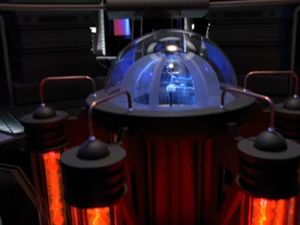Quantum Slipstream Drive
| Academy Library |
|---|
After the return of Voyager from the Delta Quadrant, Starfleet began analyzing the various new technologies they brought with them. The Vesta-class was the first to include the slipstream technology as its native and primary source of faster-than-light propulsion. In 2390, Starfleet gave final authorization for slipstream drives to be installed on new ships. Older ships would be called back for refit as befitting their mission and requirements. The primary goals of Starfleet in utilizing the new technology was expanding the reach of the Federation and enabling faster travel in cases of emergency. Operations guideThe Starfleet Corps of Engineers has prepared the following document for reference: Basics of Quantum SlipstreamSpeedThe standard Starfleet slipstream drive allows for travel at warp-factor 9.99998477, or 300 light years per hour. Drive staminaAt its current technological advancement, Starfleet slipstream drives can only be operated for a maximum of approximately 12 hours before initiating auto-shutdown procedures. This allows a ship to travel 3,600 light years from where they started.Warm-up timeStarfleet slipstream drives require a warm-up cycle before they can be engaged. This warm-up cycle requires 40 minutes of preparation by a trained Starfleet Engineering Officer. Cool-down timeOnce the drive is deactivated, it cannot be reactivated for at least 36 hours. Any attempt to warm-up the drive before the cool-down cycle has completed could result in an unstable slipstream. Upgrade cycleAs the technology rolls out to the fleet, it will be necessary for ships to return to spacedock, on average, every two years for a minor refit and hull inspection to ensure that the slipstream drives are not compromising the long-term integrity of the fleet. |




